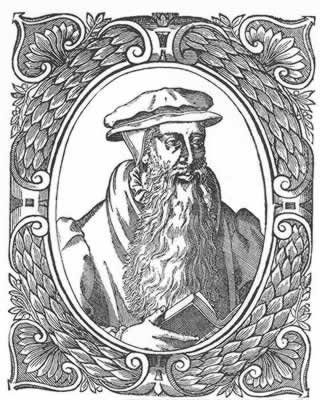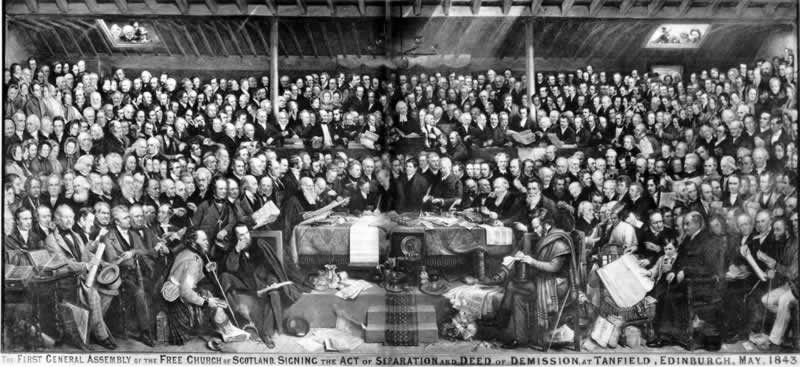History of the Scottish Kirk from 1560
The Scottish Reformation of 1560 happened as a reaction to the corruption and spiritual decline of the Roman Catholic Church that had until that point guided the nation’s morality for hundreds of years. ‘Heretical’ ideas from the continent were already penetrating the country through preachers such as George Wishart, martyred in St. Andrews in 1546, and with the increasing resentment of the population against the French, who were turning Scotland into a puppet state, revolution was inevitable.
Shortly after Wishart’s execution, the man responsible, Cardinal Beaton, was murdered by protestant sympathisers in St. Andrew’s, and the town’s castle briefly captured, before returning to French control. One of Wishart’s protégés, a priest by the name of John Knox, was taken prisoner for 18 months, but upon his release made his way to England, and then Switzerland, where he studied the reformer John Calvin, who had created a Protestant mini-state in Geneva based on the principle of the “Godly Commonwealth”, by which the church controlled the education and discipline of its population.
Impressed, Knox returned to Scotland, and managed to convince the Scottish anti-French nobles and laity that revolution should sweep clear the old order. With his fiery sermons underpinning the cause, Catholic monasteries throughout Scotland were sacked. Things came to a head in February 1560 after English intervention, and a treaty soon saw France withdraw from Scotland, cementing the revolution.
The revolutionary settlement, known as the 'Reformation', soon bedded in and a new social order was introduced into Scotland that now began to challenge the authority of the Scottish state itself. The Crown had previously exerted its control through the Roman Catholic bishops, who oversaw the priests, who oversaw the people. Presbyterianism completely reversed this, by giving the power to control religious affairs to the people. For the next 130 years, the church and the state were to play tug of war over the role of bishops.
Initially, the Kirk had actually retained the structural role of bishops by creating ‘superintendents’ to oversee the parishes. In 1572, the Concordat of Leith, with the blessing of John Knox, agreed to appoint Protestant bishops nominated by the Crown. But when Andrew Melville came to inherit Knox’s mantle, he sought and achieved the abolition of these bishops. To him, Presbyterianism meant that no man should be held up in authority over another, as he could see no evidence in the Bible that the earliest Christian churches had ever been hierarchical. Melville also neutered the General Assembly, turning it into a talking shop for ministers. The Crown no longer had a vehicle to exercise its control, and refused to ratify the new Kirk’s presbyterian structure until eventually conceding in 1592.
Desperate to regain its influence, the Crown in essence bribed the Kirk in 1610, seven years after the Union of the Crowns, to reintroduce some form of episcopacy in return for major investment in the Kirk’s infrastructure. If it was not for a small, hardline, theological faction within the Kirk, they would have succeeded. The Crown’s action was certainly not popular with the general public, and crisis point was soon reached.
In 1636 and 1637, Charles I revealed new proposals to assimilate the Church of Scotland with that of England, through a much more stringent Episcopalian policy, including a new prayer book and the reintroduction of the mass, albeit on Anglican lines. This was too much for the Kirk, and a protest document known as the National Covenant was signed across the country, condemning the move. Branding the signatories as traitors, Charles threatened to march an army to Scotland, but capitulated at the last moment, allowing a General Assembly to convene, which to his horror then abolished the role of bishops in Scotland. War was declared against the ‘Covenanters’, which soon escalated into a civil war across Britain. Charles was ultimately defeated, and an English republic or “Commonwealth” was established under Oliver Cromwell, who had by now turned against the Scots Covenanters.
After Charles’ execution, his son landed in Scotland, and in a bid to win Scottish support, agreed to support Presbyterianism. He was restored to the throne in 1660 – and duly went back on his word. Episcopacy was reintroduced into Scotland, with three hundred ministers soon removed from their churches after refusing to accept the role of bishops. They took to preaching in secret at open air ‘conventicles’, and were branded seditious. Now a new Covenanting army was raised in 1666 against the king, but it was defeated at Rullion Green. When Archbishop James Sharp was then assassinated in 1679, open warfare existed between the King’s troops and the Covenanters, in what became known as the “Killing Times”.
By 1685, Charles II had given way to his brother, James VII. To the protestant Scots, things were now much worse – James was a Roman Catholic. Matters came to a head in 1688 when James was forced to leave Britain, his place usurped by his nephew, William of Orange. William secured the settlement of the “Glorious Revolution” by defeating his uncle’s Jacobite forces at the Boyne and Aughrim in 1690, and as part of the resultant peace dividend the bishops were finally kicked out of the Scottish Kirk forever.
Many of those who had adhered to episcopalianism remained within the Scottish Episcopal Church, which drifted ever closer in tone towards a more Catholic flavour, becoming very heavily identified with the Jacobite causes of the Eighteenth century. Another church which remained separate from the established church after 1690 was that of the covenanter Cameronians, later to become the Reformed Presbyterian Church.
But with Presbyterianism now secured, the mainstream churches soon began to turn in on themselves over points of doctrine, with one point in particular – patronage. With the loss of bishops and then superintendents, landowners began to assert their rights to influence the choice of appointments in Presbyterian kirk sessions and ministries. Many church ministers became increasingly uneasy about this, and it was not long before factions began to remove themselves from the establishment church in protest, such as Ebeneezer Erskine’s Secession Church in 1733. There then followed a further number of splits, such as that in 1747 between those in the Secession Church who would and who would not take the Burgher Oath in 1745, which was in fact designed to prevent Roman Catholics taking office after the second Jacobite rebellion.
The established Church of Scotland was still dominant, but the situation worsened for them in the 19th century, particularly with the development of large urban populations, with which the church’s parochial structure could not cope. With the urban authorities trying to regain control of the masses, another Kirk minister, Thomas Chalmers, and his evangelical wing of the Church of Scotland tried to relaunch the Calvinist concept of a “Godly Commonwealth”, by trying to address the issue of patronage once and for all, with a return to the values of the true Presbyterian church which they believed had lost its way. However, when the established church refused to challenge the state authorities on the issue, Chalmers and a third of the delegates at the 1843 General Assembly meeting walked out in protest, forming the Free Church of Scotland.
Unfortunately for both the Free Church and the established church, their timing could not have been worse in terms of their Protestant objectives. Within a few years, thousands of Roman Catholic Irish people were arriving in Scotland to flee the Famine in their homeland. With both the mainstream Protestant churches doubling up on their efforts to create new ministries and missions, both became seriously weakened at the time that Roman Catholicism was able to embed itself again securely within the country – and with State backing.
Eventually, both churches were soon forced to realise that reunification was the only way to regain their dominant position, but by the time they got their act together in 1929 it was too late. Education and discipline were by now firmly in the hands of what was now a fully secular Scottish state. As the churches merged, they were also disestablished, and the idea of the Godly Commonwealth breathed its last.
Sources:
i) “A History of the Scottish People 1560-1830” – T.C. Smout, Fontana, 1998 (first pub William Collins and Son, 1969)
ii) “Religion & Society in Scotland Since 1707” – Callum G. Brown, Edinburgh University Press, 1997.
iii) “The Sword and the Cross – Four Turbulent Episodes in the History of Christian Scotland” – pub. Saint Andrews Press, 2003
Author: chrispaton
Back to Scotland


